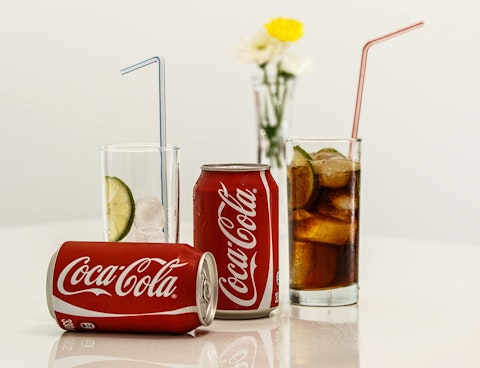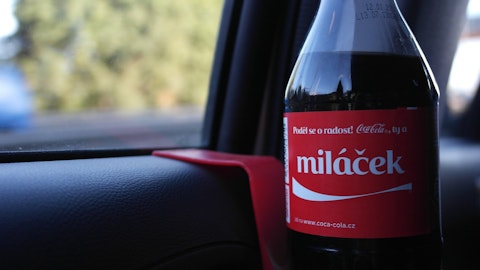The Coca-Cola Company (NYSE:KO) Q2 2023 Earnings Call Transcript July 26, 2023
The Coca-Cola Company beats earnings expectations. Reported EPS is $0.7, expectations were $0.65.
Operator: At this time, I’d like to welcome everyone to the Coca-Cola Company’s Second Quarter 2023 Earnings Results Conference Call. Today’s call is being recorded. If you have any objections, please disconnect at this time. All participants will be in a listen-only mode until the formal question-and-answer portion of the call. I would like to remind everyone that the purpose of this conference is to talk with investors and therefore questions from the media will not be addressed. Media participants should contact Coca-Cola’s Media Relations Department if they have any questions. I would now like to introduce Ms. Robin Halpern, Vice President and Head of Investor Relations. Ms. Halpern, you may now begin.
Robin Halpern: Good morning, and thank you for joining us. I’m here with James Quincey, our Chairman and Chief Executive Officer; and John Murphy, our President and Chief Financial Officer. We’ve posted schedules under Financial Information in the Investors section of our company website at cocacolacompany.com. These schedules reconcile certain non-GAAP financial measures which may be referred to by our senior executives during this morning’s discussion to our results, as reported under Generally Accepted Accounting Principles. You can also find schedules in the same section of our website that provide an analysis of our gross and operating margins. In addition, this call may contain forward-looking statements, including statements concerning long-term earnings objectives, which should be considered in conjunction with cautionary statements contained in our earnings release and in the company’s periodic SEC reports.
Following prepared remarks, we will turn the call over for questions. Please limit yourself to one question. If you have more than one, please ask your most pressing question first and then re-enter the queue. Now I’ll turn the call over to James.
James Quincey: Thanks, Robin, and good morning, everyone. After a strong start to the year, we continued our momentum in the second quarter. Our combination of strong love brands and an aligned pervasive distribution system is allowing us to win in many different operating environments. Given our strong first half results and the resilience of our business, we are raising both our top line and bottom line guidance today. To give you the full picture of our results and our raised guidance, I’ll start by discussing second quarter performance and provide perspective on the current business and consumer environment. Then I’ll highlight our performance across categories, including how we are driving quality leadership throughout our portfolio.
Finally, I’ll touch on why we’re confident in our ability to deliver our long-term objectives and then John will end by discussing our results for the quarter and our revised guidance for 2023. In the second quarter, competing macro forces were at play across our markets. On the positive side, many supply chain pressures eased, concerns surrounding the stability of the banking sector diminished, and energy prices continued to pull back from record highs. However, global inflation was still elevated and geopolitical tensions continued to exist in some markets. Despite this confluence of factors, we delivered 11% organic revenue growth in this quarter. Volume was flat and after a slower start, it sequentially improved, with June being our strongest month in the quarter.
In the first half of 2023, we delivered volume growth that was consistent with our underlying performance since 2019. More broadly, our industry is strong and we believe we have significant headroom to grow both volume and value and we continue to gain share. During the quarter, we gained value share in both At-Home and Away-From-Home channels. As we look towards the second half, the global inflationary environment is impacting consumers and our business differently across geographies. In developed markets like North America and Western Europe, inflation is beginning to moderate and labor markets remain strong. Our elasticities continued to be relatively low. However, we have seen some willingness to switch to private label brands in certain categories.
Across the sector, consumers are increasingly cost conscious. They’re looking for value and stocking up on items on sale. In these markets, our pricing is largely in place and is expected to moderate as we cycle pricing initiatives from the prior year. It’s more important than ever to be consumer centric and to partner with customers to provide affordable and premium propositions which deliver value through basket and incidents growth. In many developing and emerging markets like Latin America, the Middle East and Africa, consumers are more accustomed to persistent inflation. However, the number of markets with intense inflation has expanded. Five of our top 40 markets are currently experiencing over 20% annual inflation. In these markets, it’s equally important to leverage revenue growth management capabilities to balance affordability with premiumization to be able to take price with local market inflation, which helps offset the currency pressures.
There are, as always, a few markets affected by specific local factors. In China, economic recovery slowed in the second quarter and inflation has declined. Consumer confidence is below pre-pandemic levels and we continue to monitor our leading consumer indicators and take action to win in the market. In India, business was unfavourably impacted by unseasonable rain and cooler temperatures in the quarter. However, the growth outlook remains intact. In a world with a wide spectrum of market dynamics, from inflation to currency devaluation to shifting consumer needs, our business is proving to be very resilient. We have many levers to pull to manage successfully through different operating environments, and we remain consumer centric and focused on growth.

Pixabay / Public Domain
A Recipe for Success is unchanged. We continue to deliver on our strategy through a combination of world class marketing and innovation, excellence in revenue growth management and strong execution. We are raising the bar and increasing quality leadership across our portfolio. Starting with Coca-Cola. We are growing our base of Gen-Z drinkers, gaining share and leveraging our scale to drive efficiencies across our system. During the quarter, we gained volume and value share by linking Coca-Cola to consumption occasions and engaging consumers through local experiences. A great example is A Recipe for Magic, which was activated more than 50 markets and celebrates consuming Coca-Cola with meals. The campaign was supported by experiences using local chefs, leveraging approximately 750 influencers globally and was brought to life through social media and recipe focused billboards.
The Coke and Meals campaign also allows Coca-Cola to strengthen its local relevance. For instance, in the Away-From-Home channel in Italy, Coca-Cola has grown incidence with Pizza, the number one consumed meal with approximately 3 billion pizzas each year from 10% to 20% over the past four years. While the Coca-Cola brand is ubiquitous, we tailor our price pack architecture to consumption occasions and are continuing to drive both affordability and premiumization. During the second quarter, we grew basket incidence and volume per trip by double-digits while increasing price per liter. Moving on to sparkling flavors. We are seeing strong engagement from consumers across our stapler brands, which includes Sprite, Fanta, Fresca and Thums Up. At the same time, we have significant headroom to drive further quality leadership across developed and developing markets.
With Sprite, we are driving brand awareness by connecting consumers to passion points and personalized experience at a more granular and locally relevant levels through our global Heat Happens platform. In North America, Sprite celebrated Hip-Hop’s 50th anniversary with the launch of Sprite Lymonade Legacy and sponsorship of concert tours, exclusive experiences and collaborations with prominent artists. We partnered with local pop stars and a Grammy producer in China using our global Sprite Limelight music program for Gen-Z drinkers across 1500 college locations. In South Korea, the Sprite Waterbomb Festival similarly generated strong results. In India, the Joke-in-a-Bottle promotion allowed consumers to scan packages and receive customized and localized jokes through WhatsApp to beat the heat.
In June, Sprite was awarded Most Resilient Brand by Kantar for adding the greatest number of new households in 2022 of any FMCG brand. Turning to water, sports, coffee and tea. We are segmenting the broader opportunities and using our refreshed resource allocation capabilities to prioritize markets and subcategories that offer the highest return on our investment. We are building our edge through consumer centricity by accelerating the speed to market of our innovation, measuring results in real-time and scaling successes. We continue to build excitement for Fuze Tea through the rollout of Green Tea in Mexico. Some are limited edition in Turkey and expansion of Zero Sugar offerings across Europe. Early results show promising velocities and Fuze Tea grew volume double-digits during the quarter.
Vitaminwater is another example. During the quarter, we relaunched Vitaminwater Zero in North America with a new sweetener system of Monk Fruit and Stevia, which generated value share gains. We are capitalizing on consumer needs for rapid hydration, a fast growing sub-segment within sports drinks with the launch of BODYARMOR Flash I.V. in the US and FlashLyte in Mexico. While still early, both saw strong consumer interest during the quarter and have demonstrated promising initial results. Juice value added dairy and plant-based beverages have delivered nine consecutive quarters of double-digit top line growth and gained both volume and value share during the quarter. We continue to innovate and drive premiumization under the Simply trademark, Simply Mixology, which provides consumers with great-tasting mixers and ready-to-drink mocktails.
kicked off an experiential campaign that celebrated the start of the summer and its national rollout. Also, Fairlife had another exceptional quarter as both Core Power and Fairlife nutrition plan continued their strong momentum. In May, we announced a $650 million investment to build a state-of-the-art production facility to help drive the next wave of growth. Finally, we are encouraged by what we are seeing across alcohol ready-to-drink beverages. We continue to take a measured approach through exploring and applying our learnings. While it’s still early, Jack and Coke has shown promising results. In the Philippines, the combination of Jack and Coke and Lemon-dou delivered strong share gains. The Schweppes Mojito rollout in India is also off to a good start.
And these examples illustrate how our marketing transformation is coming to life. The strength of our total beverage portfolio gives us further confidence that we can continue to deliver by providing consumers beverage choices for every occasion. Our purpose is to refresh the world and make a difference. And we remain committed to building a more sustainable future for our company and the planet as we strive to grow our business. We continue to pursue progress toward our vision of a circular economy for packaging through innovation and partnerships. For example, in the US, we recently partnered with Republic Services to ensure we have an adequate supply of recycled plastic for our packaging. At the same time, we are embracing refillables. We recently kicked off a program with customers in four US cities to test refillable fountain cups with plans to expand elsewhere.
We’ve successfully navigated the first half of the year, which supports our decision to raise guidance for the full year. And instead of trying to predict the many directions things could take, we remain focused on delivering our key objectives that we outlined in February. In other words, number one, pursuing excellence globally and winning locally through relentless consumer centricity to drive top-line momentum. Two, investing for the long-term health of our business and raising the bar across all elements of our strategic flywheel. And three, generating US dollar EPS growth. Our system has never been stronger and our global network model is allowing us to quickly adapt to changing environments. We believe we are well positioned to deliver our updated guidance and objectives, thanks to our incredible system employees around the world.
With that, I’ll turn the call over to you, John.
John Murphy: Thank you, James, and good morning, everyone. We are pleased with the momentum of our business and our strong second quarter results. Starting with the top line, we grew organic revenues 11%. Unit cases were flat. As James said, volume for the second quarter got off to a slower start, but ended on a positive note. Concentrate sales were one point ahead of unit cases for the quarter, primarily driven by the timing of concentrate shipments. Price mix growth was 10% for the quarter, driven by carryover pricing coming into the base from last year, along with some new pricing actions across operating segments, including the impact of hyperinflationary markets. Comparable gross margin for the quarter was up approximately 40 basis points, driven by underlying expansion and a slight benefit from bottler refranchising partially offset by the impact of currency.
Comparable operating margin expanded approximately 90 basis points for the quarter. This was primarily driven by strong top line growth and the impact of refranchising bottling operations. Partially offset by an increase in marketing investments and higher operating costs versus the prior year as well as currency headwinds. Putting it all together, second quarter comparable EPS of $0.78 was up 11% year-over-year despite higher than expected 6% currency headwinds. Free cash flow was approximately $4 billion year-to-date. This was largely attributable to strong underlying operational performance and working capital benefits, partially offset by a $720 million transition tax payment that was made during the second quarter as well as M&A related payments.
Our balance sheet is strong and our net debt leverage of 1.6 times EBITDA is below our targeted range of 2 to 2.5 times. Our capital allocation priorities remain the same and we continue to invest to drive long-term growth. As James mentioned, we are encouraged by what we are seeing in the marketplace. While we continue to spend our strategic flywheel faster to generate top line led growth, we’ve also progressed on a margin agenda, as demonstrated by our consistent track record of offsetting cost headwinds to sustain steady gross margins. We have numerous levers available to drive top line growth and improve the effectiveness and efficiency of our spend over the long-term. Our all-weather strategy, coupled with the great plans that we have in place to continue to create quality leadership across our portfolio give us good visibility to deliver on our raised 2023 guidance.
This is comprised of organic revenue growth of 8% to 9%, which includes positive volume growth while continuing to be led by price mix. There are a few considerations to keep in mind. We expect pricing in developed markets to moderate through the year as we cycle pricing initiatives from the prior year. In developing and emerging markets, we aim to take price with local market inflation. To the extent that intense inflationary markets drive elevated price mix. The impact is oftentimes offset by currency, as it is frequently difficult to hedge our exposure. Due to our reporting calendar, there will be one additional day in the fourth quarter. We now expect comparable currency neutral earnings per share growth of 9% to 11%. Based on current rates and our hedge positions, we are updating our currency outlook of an approximate 3 to 4 point headwind to comparable net revenues and an approximate 4 to 5 point currency headwind to comparable earnings per share for full year 2023.
Inflationary pressures are beginning to moderate in some ways, including freight rates that are favorable compared to last year. That said, several commodities that are prevalent in our basket like sugar and juice remain elevated and we have some hedges that we will be rolling off to less favorable rates. Based on current rates and hedge positions, we continue to expect per case commodity price inflation in the range of a mid-single digit impact on comparable cost of goods sold in 2023. Our updated underlying effective tax rate for 2023 is now 19.3%. All-in, we are updating comparable earnings per share growth of 5% to 6% versus $2.48 in 2022. We continue to expect to generate approximately $9.5 billion of free cash flow in 2023 through approximately $11.4 billion in cash from operations less approximately $1.9 billion in capital investments.
If you exclude the transition tax payment made in the second quarter and various payments associated with M&A transactions, our implied free cash flow conversion would be within our long-term guidance. This guidance does not include any payments related to our ongoing US income tax dispute with the IRS. As we enter the second half of the year, we continue to build a culture that emphasizes raising the bar in every aspect of how we do business. Thanks to the tremendous ongoing commitment of our system employees around the world, we are confident in our ability to deliver on our guidance for 2023 and drive value for our stakeholders over the long-term. With that operator, we are ready to take questions.
See also Top 50 Countries with the Most Beautiful Women in the World and 30 Best Excuses to Get Out of Work Provided By AI Chatbots.
Q&A Session
Follow Coca Cola Co (NYSE:KO)
Follow Coca Cola Co (NYSE:KO)
Operator: [Operator Instructions] Our first question comes from Bryan Spillane of Bank of America. Please go ahead. Your line is open.
Bryan Spillane: Hey, thanks, operator. Good morning, everyone. I guess I have a question about just as we kind of look into the back half of the year and looking at organic sales, the implied organic sales guidance, which I guess is in the kind of the 5 to 6% range in the back half of the year. Maybe James and John, can you just talk a little bit about how maybe the just the macro environment or you know the operating conditions are today versus what you were thinking at the start of the year? And given that there’s, you know, more of these markets where countries where hyperinflation is an issue, is price a little bit more of a driver in terms of the organic sales comp in the back half of the year relative to volume again versus kind of what you were thinking at the start of the year?
James Quincey: Yeah. Good morning, Bryan. Yeah, let me try and unpack that a little bit. I think the headline part of the answer is there’s a little more pricing in Q2 and in the downhill than we had expected at the beginning of the year, principally around that basket of countries where inflation is high above 20% and a little more persistent. That’s the short answer. The longer version of the answer is, look, we’re executing the strategy we’ve talked about consistently over time and again in CAGNY, the real focus on upping the bar on marketing, upping the bar on RGM, the commercial strategies and the execution of the marketplace. All with the intent about delivering a good strong top line led growth algorithm. And obviously that we’ve talked historically, that is normal, normal times that 5% to 6% would be split between volume and price on a roughly equal basis.
And so what you’re seeing in the back half of the year, which I think is important to note, is we’re expecting volume to be consistent in the second half with the way it was in the first half, which in the end is running on a trend, if you like, a CAGR versus 2019, similar to what we did last year. So we see, you know, sustained positive volume growth coming out of ’22 and we’re looking for volume growth in the second half in a very similar way to the first half, whether you’re comparing to prior year or to 2019. So we want a business that is growing consumer base for all the right appropriate strategic reasons. Then what’s going to happen to revenue in the second half is we’re going to see the impact of three buckets of price mix. The first bucket is the carryover of pricing from prior year.
Obviously there was more cost inflation last year, but logically that is a set of numbers that is going to tend to zero by the end of December. And so that is going to step down as we go through Q3 and Q4. So bucket one carryover that’s going to step down. Bucket two is price increases we’ve made so far this year that are leaving aside the large inflation countries look much more like a normal year in terms of what we’ve taken this year, both in terms of timing, number of price increases and relative level of price increases. So we’re —
Operator: Ladies and gentlemen, we are experiencing technical difficulties. Please stay on the line.
James Quincey: When did I stop? Operator do you know when the line cut on my answer?
Operator: Unfortunately not, sir. Our next question will come from Lauren Lieberman from Barclays. Please go ahead. Your line is open.
James Quincey: Hang on, one sec, operator.





